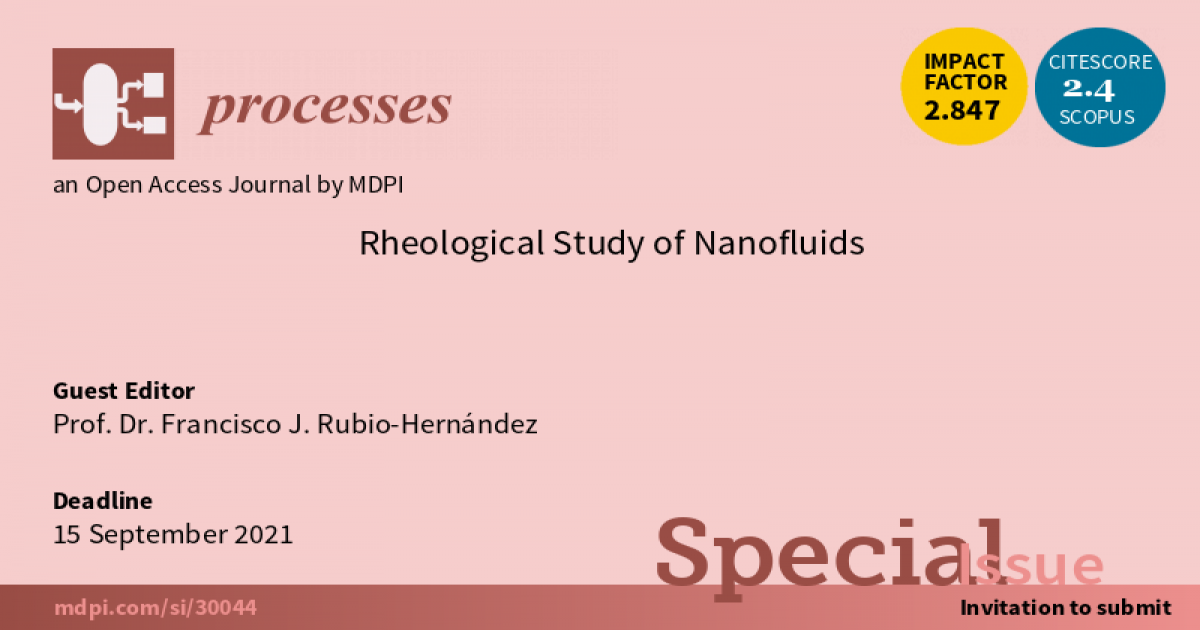Rheological Study of Nanofluids
A special issue of Processes (ISSN 2227-9717). This special issue belongs to the section "Materials Processes".
Deadline for manuscript submissions: closed (15 September 2021) | Viewed by 21559

Special Issue Editor
Interests: colloidal suspensions rheology; thixotropy; shear-thickening; non-linear viscoelasticity; electrorheology; electroviscous effects
Special Issue Information
Dear Colleagues,
Nanofluids are suspensions of nano-metric-sized solid particles dispersed in liquid media. Although colloidal interactions determine the stability of these fluids against sedimentation, hydrodynamic forces are also decisive for the flow behavior of nanofluids.
Science usually precedes effective engineering applications. This is especially applicable to nanofluids considering the broad interest, initiated at the beginning of the new century, to find useful applications. Some of which are related to solar energy, heat transfer, biomedicine, automotive, mass transfer, lubricants, or smart fluids.
In most of these applications, the flow behavior of nanofluids should be well characterized. On the other hand, as nanofluids are non-Newtonian, showing shear-thinning, shear-thickening, or viscoplastic behavior depending on the shear forces they support, this task is clearly justified.
The aim of this Special Issue is to provide a state of the art on the rheological behavior of nanofluids considering the possible correlations between rheological and relevant properties for applications of nanofluids.
Dr. Francisco J. Rubio-Hernández
Guest Editor
Manuscript Submission Information
Manuscripts should be submitted online at www.mdpi.com by registering and logging in to this website. Once you are registered, click here to go to the submission form. Manuscripts can be submitted until the deadline. All submissions that pass pre-check are peer-reviewed. Accepted papers will be published continuously in the journal (as soon as accepted) and will be listed together on the special issue website. Research articles, review articles as well as short communications are invited. For planned papers, a title and short abstract (about 100 words) can be sent to the Editorial Office for announcement on this website.
Submitted manuscripts should not have been published previously, nor be under consideration for publication elsewhere (except conference proceedings papers). All manuscripts are thoroughly refereed through a single-blind peer-review process. A guide for authors and other relevant information for submission of manuscripts is available on the Instructions for Authors page. Processes is an international peer-reviewed open access monthly journal published by MDPI.
Please visit the Instructions for Authors page before submitting a manuscript. The Article Processing Charge (APC) for publication in this open access journal is 2400 CHF (Swiss Francs). Submitted papers should be well formatted and use good English. Authors may use MDPI's English editing service prior to publication or during author revisions.
Keywords
- Nanofluids
- Rheology
- Colloidal suspensions
- Non-Newtonian nanofluids
Benefits of Publishing in a Special Issue
- Ease of navigation: Grouping papers by topic helps scholars navigate broad scope journals more efficiently.
- Greater discoverability: Special Issues support the reach and impact of scientific research. Articles in Special Issues are more discoverable and cited more frequently.
- Expansion of research network: Special Issues facilitate connections among authors, fostering scientific collaborations.
- External promotion: Articles in Special Issues are often promoted through the journal's social media, increasing their visibility.
- e-Book format: Special Issues with more than 10 articles can be published as dedicated e-books, ensuring wide and rapid dissemination.
Further information on MDPI's Special Issue polices can be found here.





